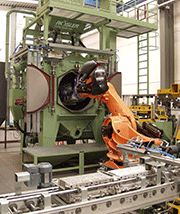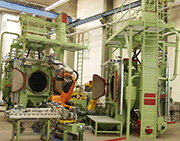E-Archive
Cover Page
in Vol. 14 - January Issue - Year 2013
Innovative shot blasting solutions for foundries. An Efficiency Boost For The Surface Preparation Of Castings

The cylinder heads with (L) x 320 (B) x 150 mm (H) -- 20 x 12.6 x 5.9 inches

The operating scope of this high performance blasting system "Roboblaster" with one arm robot comprises deburring, surface finishing, as well as shot peening of impact sensitive components of various dimensions
In the foundry industry, shot blasting is a key surface treatment technology for producing the required surface finishes. Recent developments in the automation of shot blast processes have contributed towards significant improvements in the cost effectiveness and quality of the surface preparation function; at the same time, they have expanded the range of applications for this technology.
For example, when it comes to the quality of the surface finish and cost efficiency of high volume production castings for the automotive industry, the technical and cost requirements are extremely challenging. This was also the case with the specifications for a shot blast system for the removal of residual core sand and general blast cleaning of cylinder heads which a renowned car manufacturer in Southern Germany presented to various shot blast equipment suppliers. The products with dimensions of 510 (L) x 320 (B) x 150 mm (H) -- 20 x 12.6 x 5.9 inches – and a weight of 18.8 kg (41.4 lbs) are produced by gravity die-casting technology.
In compliance with the customer specifications, Rösler developed a blast system concept on the basis of the innovative Roboblaster; the combination of a shot blast machine with a 6-axis robot that can be used for a variety of applications: from bur and sand removal all the way up to shot peening. Key factors in the customer’s decision for the Rösler RROB 800/750-4 were the excellent performance of a similar Roboblaster shot blast system from the supplier in Untermerzbach running at one of the car manufacturer’s facilities and Rösler’s compliance with the capacity requirements.
A 16 second shot blast cycle time
The Rösler shot blast system consists of two machines and one robot alternately loading parts into the two blast machines. This concept complies with the "redundancy" requirement, i.e., in case one shot blast machine becomes inoperable, the manufacturing process does not have to be stopped. The specified cycle time limit of only 16 seconds was met by the Rösler engineers with a dual gripper allowing the robot to pick up two parts at the same time.
The cylinder heads are transported to the robotic shot blast cell with a roller conveyor equipped with a cross transfer unit. There, the parts are precisely positioned for pick up by the robot gripper. In the blast chamber, the duplex gripper places the cylinder heads on parts-specific work piece fixtures, and subsequently moves out of the blast chamber. After the blast chamber door has been closed, the hinged turbine flaps open to initiate the flow of blast media, whilst at the same time, the work piece fixtures with the mounted cylinder heads start rotating. This rotational movement ensures a homogeneous and complete coverage of the part surface without any "shadow" effect. The blast media consists of stainless steel shot with sizes of 0.5 – 0.8 mm.
After the blast cycle, the turbine flaps are closed to stop the media flow. The work piece fixtures continue rotating until the chamber door is completely open. This allows the initial removal of residual blast media and core sand from the parts while they are still in the blast chamber.
Each blast machine is equipped with four high-performance turbines, type Hurricane H 42, with a diameter of 420 mm (16.6 inches) and an installed drive power of 15 kW each. The optimum placement of the turbines with their required tilt angle was determined by the Rösler engineers using a 3D simulation of the shot blast process.
To minimize the equipment wear caused by the high blast intensity, the blast chamber and work piece fixtures are made from extremely wear-resistant manganese steel. In addition, the inside of the blast chamber is lined with easy-to-replace overlapping 12 mm thick manganese steel plates.
The challenging task of removing residual blast media
The stringent customer requirements did not only apply to cycle time and precision of the automated process but also extended to the allowable residual blast media/core sand in the cylinder heads. The specification of only 0.5 grams per part required a highly sophisticated solution: After the shot blast process, the robot transfers the cylinder heads in pairs of two into a blast media removal system comparable to a Ferris wheel. The parts are moving in a precise orbit while at the same time being rotated in different, pre-defined directions. In addition, a vibratory motor mounted to the wheel frame induces vibrations in the cylinder heads which help shake out blast media from the difficult-to-reach areas in the water channels.
Effective media classification with dual stage air wash separator
The small sand quantity in the blast media (only residual core sand) did not require a magnetic separator. It was possible to handle the media classification with a more economical dual- stage air wash separator. This cleaning system ensures full compliance with the specified residual contamination in the blast media of < 0.1 (% of the media volume) and media loss of < 1% during the media classification process.
When it comes to space requirements, the Roboblaster could also fully meet the customer’s expectations: Including an all-around noise protection cabin, the complete system could be placed in an area of only 10.4 x 8.6 m (34 x 28 ft). To allow maintenance work on the shot blast machines during the 3-shift operation, the work area of the robot is enclosed with a safety fence. The complete shot blast system was installed on the first floor of the customer’s foundry. The system components were broken down so that they could easily be transported in the on-site heavy duty elevator with dimensions of 6 x 4 x 3 m (app. 20 x 13 x 10 ft).
For Information:
Barbara Müller
Rösler Oberflächentechnik GmbH
Vorstadt 1
96190 Untermerzbach, Germany
Tel. +49.9533.924-0
Fax +49.9533.924-300
E-mail: info@rosler.com
www.rosler.com




























